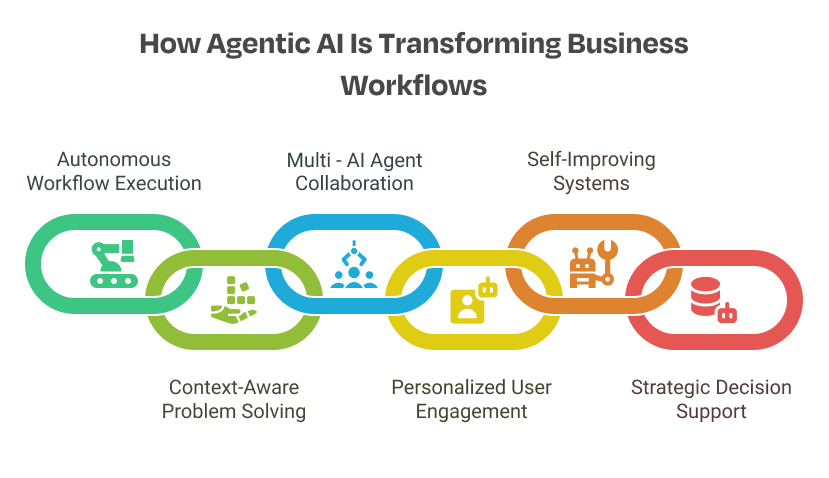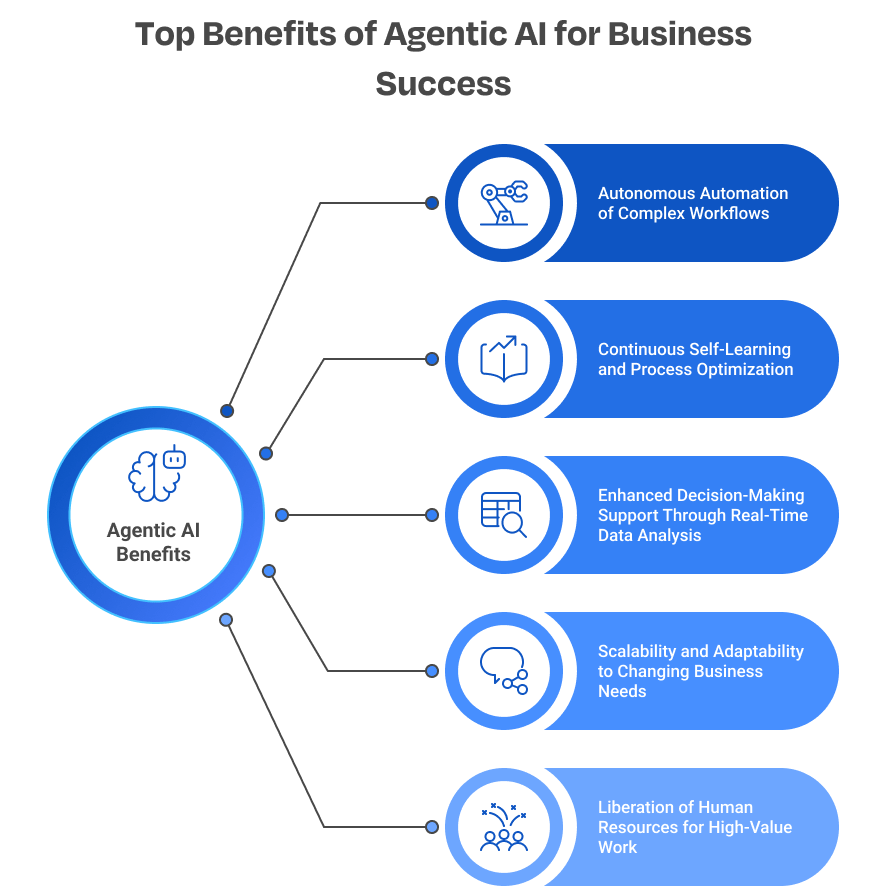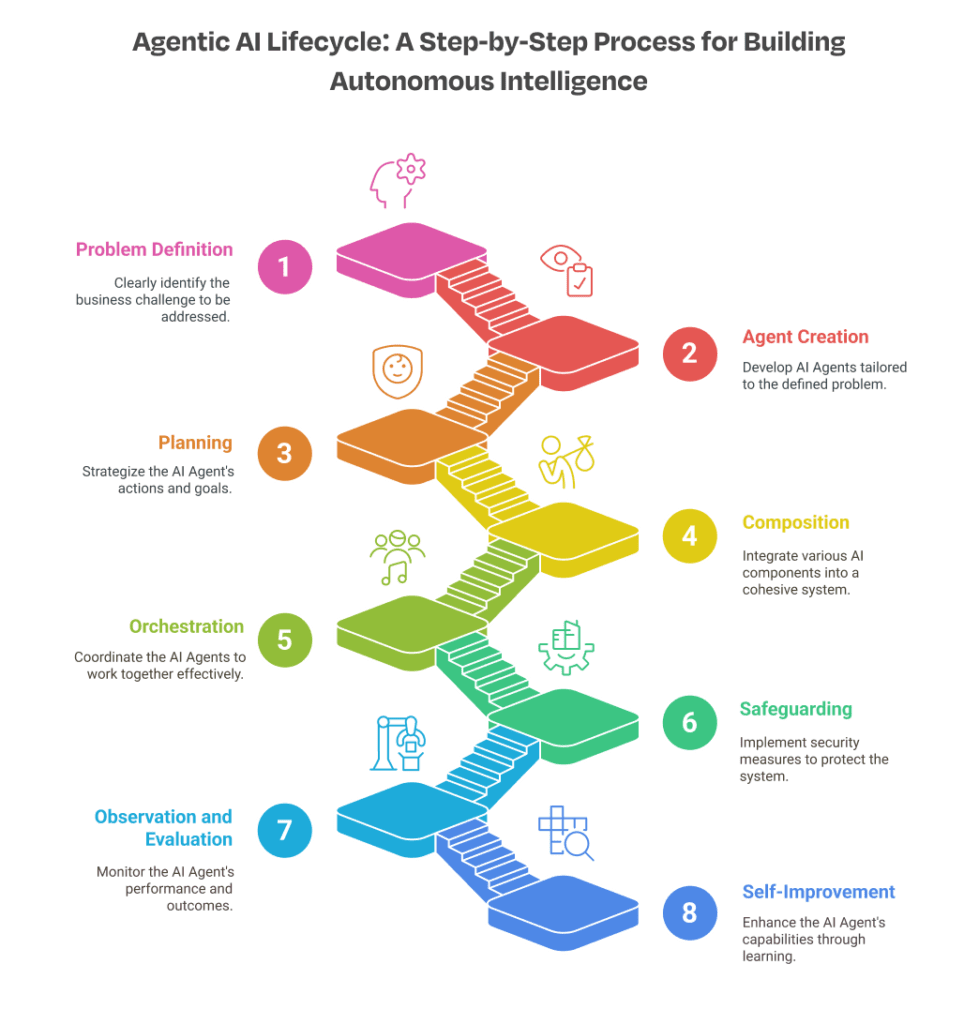Introduction
Let’s understand about Agentic AI in depth!
What is Agentic AI?
- Gather real-time data to stay aware of their surroundings.
- Analyze complex situations and make thoughtful, step-by-step decisions
- Act autonomously to carry out tasks and interact with digital systems.
- Learn from successes and failures to improve over time.
- Collaborate with other agents and humans to achieve shared goals.
At its core, Agentic AI gives artificial intelligence the ability to act with purpose. Instead of waiting for prompts, it anticipates needs, identifies opportunities, and initiates actions. And this proactive intelligence is what makes it such a game-changer for modern enterprises.
Traditional AI vs Generative AI vs Agentic AI: What’s the Difference
| Feature | Traditional AI | Generative AI | Agentic AI |
|---|---|---|---|
| Core Function | Automates specific, rule-based tasks like classification or predictions | Generates content such as text, images, and code based on prompts | Performs goal-driven actions autonomously and completes multi-step tasks |
| Workflow | Data collection → Rule processing → Decision → Static automation | Prompt input → Content generation → Human validation → Semi-automated creativity | Goal input → Dynamic decisioning → Tool orchestration → Continuous feedback loop |
| UseCases |
|
|
|
| Level of Autonomy | Low – Follows fixed logic and requires strict human-defined rules | Moderate – Needs prompts but can produce creative or data-driven outputs | High – Acts independently with minimal human input |
| Learning Method | Based on rule-based or supervised learning with predefined logic | Uses supervised or unsupervised learning on large datasets | Uses reinforcement learning to adapt through interaction and feedback |
| Adaptability | Poor adaptability - struggles outside of programmed conditions | Limited to what it has been trained on; lacks real-time adaptability | Continuously learns and adapts to changing contexts and new environments |
| Workflow Integration | Useful for specific functions (e.g., detecting fraud or sorting emails) | Enhances creative and data-heavy workflows like content creation or translation | Manages and optimizes entire workflows - from planning to execution |
| Real-World Examples |
Spam filters, rule-based customer service bots, credit risk scoring models | ChatGPT, GitHub Copilot, DALL·E, content summarizers | Agentic AI that schedule meetings, resolve IT tickets, manage logistics autonomously |
For businesses looking to scale intelligently, automate complex workflows, and gain a competitive edge, investing in Agentic AI systems and AI-powered agents is the next logical step in enterprise automation.
How Agentic AI Is Transforming Business Workflows

- Imagine an e-commerce company – NovaMart, a fast-scaling brand known for its eco-friendly lifestyle products. At NovaMart, when suppliers upload new products, Agentic AI automatically verifies details, checks pricing, publishes listings, and launches promotions without any human input. By independently managing this entire workflow across databases, inventory, and marketing tools, it speeds up product launches and reduces errors. This end-to-end control is a strong example of autonomous workflow execution.
- During a holiday rush, NovaMart noticed a spike in delivery complaints from one region. AI Agent scanned customer messages, analyzed logistics data, identified a warehouse issue, rerouted shipments, and sent real-time updates to affected customers. Its ability to understand the situation, act immediately, and only involve staff when necessary shows how context-aware problem solving plays out in real-time operations.
- Behind the scenes, multiple AI agents at NovaMart collaborate seamlessly – one forecasts product demand, another monitors stock, another handles shipping logistics, while a customer service agent updates delivery timelines. These AI Agents constantly share data and adjust their actions based on changes in the system, demonstrating how multi AI agents collaboration at scale can create synchronized and responsive business operations.
- When a customer visits NovaMart’s website, AI Agent observes browsing behavior, purchase history, and preferences to recommend products, personalize offers, and provide real-time assistance across channels like chat or email. This ability to adapt interactions on the fly creates a highly personalized user experience at scale, tailored to each individual.
- In another case, an AI Agent noticed a spike in product returns due to damaged packaging. It autonomously identified the root cause by analyzing return patterns, updated the packaging guidelines, and informed the fulfillment teams – all without human intervention. Simultaneously, it arranged replacement products, sent personalized apology messages, and shared tracking details with affected customers. Most importantly, the system retrained its packaging and logistics models using this incident data to improve future decision-making. This example clearly demonstrates how Agentic AI can respond to real-world feedback, adapt autonomously, and continuously refine its operations through self-improvement and learning – all at scale and without manual oversight.
- As NovaMart prepared for Black Friday, AI Agent ran simulations on different promotional strategies. It analyzed past sales data, current inventory, customer behavior, and competitor pricing to recommend the best pricing and regional plans. By forecasting outcomes and aligning resources, the AI provided strategic decision support and forecasting that helped the business avoid common peak-season pitfalls.
This is exactly how Agentic AI works in practice – as we saw through the example of NovaMart, where it streamlined operations, reduced manual effort, and enabled faster, smarter growth.
Top Benefits of Agentic AI for Business Success

1. Autonomous Automation of Complex Workflows
2. Continuous Self-Learning and Process Optimization
3. Enhanced Decision-Making Support Through Real-Time Data Analysis
4. Scalability and Adaptability to Changing Business Needs
5. Liberation of Human Resources for High-Value Work
This lifecycle enables agentic AI to function not just as a task executor – but as a self-improving artificial intelligent system that adapts to changing business needs and scales effortlessly across industries.
Agentic AI Lifecycle: A Step-by-Step Process for Building Autonomous Intelligence

1. Problem Definition
- Identifying the core business challenge or workflow.
- Defining clear goals and success criteria.
- Mapping the operational context in which the agent will function.
- Determining data requirements, availability, and sources.
2. Agent Creation
- Selecting or developing foundational models such as Large Language Models (LLMs), multi-modal models, or domain-specific AI components.
- Designing the agent architecture including memory, reasoning engines, and perception modules.
- Integrating external tools, APIs, and plugins the agent may need to interact with.
3. Planning
- Translating goals into actionable steps.
- Dynamically breaking down tasks based on context and data.
- Adjusting plans in response to changes in environment or constraints.
4. Composition
- Sequencing subtasks for logical execution.
- Coordinating between different tools or AI sub-agents.
- Combining reasoning, search, retrieval, or generation strategies to optimize performance.
5. Orchestration
- Executing subtasks in the correct order.
- Managing dependencies and timing between subtasks or agents.
- Reacting to interruptions or environmental changes as they occur.
6. Safeguarding
- Applying policy constraints and safety protocols.
- Implementing monitoring, logging, and audit mechanisms.
- Ensuring compliance with data privacy, industry regulations, and ethical principles.
7. Observation and Evaluation
- Monitoring agent behavior in real time.
- Collecting feedback from users and environmental signals.
- Analyzing performance metrics and identifying areas for improvement.
8. Self-Improvement
- Updating models through retraining or fine-tuning.
- Refining decision strategies, tool usage, or interaction protocols.
- Evolving based on new business needs or contextual information.
The Future of Agentic AI in the Enterprise
This evolution isn’t about replacing human workers – it’s about augmenting them, streamlining processes, and enabling faster, more intelligent responses across the organization. Companies that act now will gain a competitive edge through enhanced operational agility, reduced overhead, and deeply personalized customer experiences. With modern cloud infrastructure, scalable APIs, and robust LLMs making deployment more accessible than ever, the real question is no longer if businesses should implement agentic AI, but where they should begin.
How SculptSoft Builds and Deploys Agentic AI Solutions
- End-to-End Workflow Automation
We design agents that manage entire business processes – such as invoice processing, lead management, or order fulfillment – without human intervention.
- AI-Powered Customer Experience
Our conversational AI systems provide personalized, context-aware support in real time across channels like chat, email, and voice.
- Versatile Agentic AI Solutions for Diverse Business Needs
We build adaptable agentic AI systems designed to meet the specific workflows, challenges, and objectives of any business function. Whether it’s operations, customer engagement, or strategic decision-making, our agents are built to integrate seamlessly, act proactively, and evolve continuously delivering measurable impact across sectors.
- Agentic AI Building System
We develop a flexible Agentic AI system that enables the design, deployment, and scaling of custom AI agents – built to solve real business challenges across any function, without starting from scratch each time.
- Seamless Enterprise Integration
We ensure your agentic AI solutions work flawlessly with your current tech stack – whether it’s Salesforce, SAP, custom CRMs, or ERP platforms.
- Security and Compliance by Design
From day one, our solutions are built with enterprise-grade data protection, audit trails, and compliance features to meet industry-specific regulations.
What sets SculptSoft apart is our ability to bring together deep AI expertise, robust software engineering, and real-world domain knowledge. This allows us to deliver AI systems that don’t just automate tasks – but elevate how your business operates.
Conclusion
Agentic AI is not just a step forward – it’s a leap into a new era of artificial intelligence enterprise operations. By moving beyond rule-based automation to systems that can perceive, reason, act, learn, and collaborate, businesses unlock new levels of speed, precision, and strategic flexibility.
From automating complex workflows and enhancing customer experiences to delivering real-time insights and self-optimizing processes, agentic AI transforms how work gets done. It doesn’t replace human teams – it amplifies them. It doesn’t just respond – it anticipates, adapts, and evolves.
At SculptSoft, we help businesses harness this potential by building custom agentic AI systems that align with your goals, integrate with your ecosystem, and scale with your ambition.
If you’re ready to explore how autonomous Agentic AI can elevate your operations – let’s get in touch.
Frequently Asked Questions
What is Agentic AI?
Agentic AI is a new form of artificial intelligence that acts autonomously – perceiving data, making decisions, and executing tasks without human input.
How is Agentic AI different from Traditional AI and Generative AI?
Traditional AI follows fixed rules, Generative AI creates content based on prompts, while Agentic AI acts independently to achieve goals by learning, planning, and executing tasks on its own.
What are the key benefits of using agentic AI in enterprises?
Key benefits of agentic AI include:
- 24/7 automation with reduced human oversight
- Faster and more accurate decision-making
- Lower operational costs
- Personalized customer experiences
- Real-time adaptability to business changes
- Seamless system integration and compliance tracking
What industries can benefit the most from Agentic AI solutions?
Industries like e-commerce, healthcare, logistics, finance, SaaS, manufacturing, retail, telecommunications, education, real estate, and energy benefit significantly from Agentic AI. These systems automate everything from lead management and supply chain optimization to 24/7 customer support and compliance monitoring – reducing costs and increasing efficiency.
How does AI make decisions without human input?
Agentic AI, a form of autonomous AI, makes decisions using real-time data, strategic reasoning, and machine learning. It further distinguishes itself by autonomously evaluating outcomes, adjusting its behaviors, and coordinating complex actions across various systems and teams to achieve its goals.
How does Agentic AI enhance decision-making in businesses?
Agentic AI improves decision-making by analyzing real-time data, identifying patterns, and offering actionable insights. It uses predictive analytics and machine learning to simulate scenarios and recommend the best course of action – helping decision-makers act faster with greater confidence.